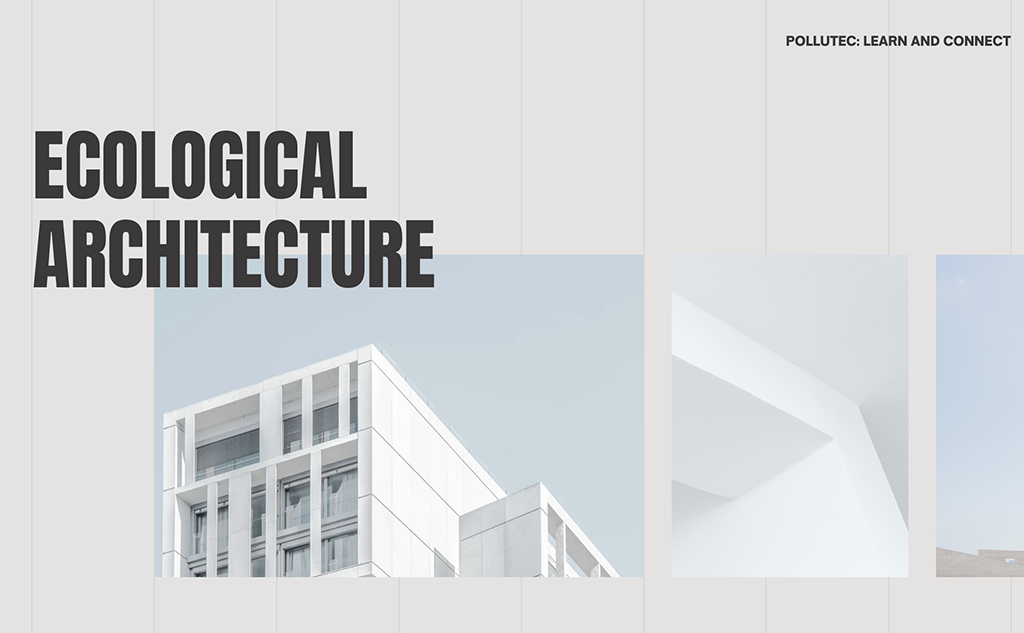There are almost eight billion of us on the planet, and our impact is now considerable. At a time of climate change and the depletion of natural resources, we urgently need to rethink the way we build and live. That’s why ecological architecture, while not new, is emerging as a solution for protecting the environment and building resilience in the face of these new challenges.
Architects are innovating to incorporate the environmental, social, and economic aspects of sustainable development into their projects. Greening, responsible materials, low energy consumption, waste reduction: ecological architecture combines sustainable architecture and green architecture. Construction is thus approached from an eco-design perspective, and considered throughout its life cycle to ensure that it is harmoniously integrated into its environment, maintains biodiversity, and enhances the well-being of its inhabitants.
History of ecological architecture
Ecological architecture may be a recent term, but it was not born yesterday. The first humans didn’t adapt nature, they adapted to it, living in caves or, later, building houses out of wood or stone. Later, again for practical reasons, but also for economic and social reasons, preference was given to building with local and natural materials and using techniques adapted to the climate. Architecture was already “ecological”.
But with the industrial revolution, fast paced urbanisation, profoundly modifying the architecture of buildings (synthetic materials) and altering natural ecosystems (artificialisation of soils, intensive exploitation and depletion of resources). It was in this context that modern ecological architecture took root, with pioneering architects such as Richard Buckminster Fuller and his geodesic dome, Franck Lloyd Wright and his concept of organic architecture, Ian McHarg and his book ‘design with nature’, and Victor Olgyay and Ken Yeang and their bioclimatic design.
Today, with the IPCC calling for ‘choices to be made for the climate and nature’, it has become inevitable to take into account the ecological footprint of buildings throughout their life cycle and to protect the environment. Ecological architecture has therefore become very popular. For architects it means to ‘eco-design’, with the emphasis on low-energy houses and buildings (optimal building orientation, use of solar energy, high-performance thermal insulation) and the use of ecological and responsible materials (biosourced, geosourced, recycled or reused). The issue of waste reduction and greening is also taken into account.
Trends and innovations in green architecture
Materials such as wood (bamboo, certified wood), brick and terracotta are enjoying a resurgence of interest for their insulating properties, low carbon footprint and low grey energy consumption (the energy required to produce the materials). They are generally used for framing, roofing or cladding.
Other environmentally-friendly materials such as plant fibres and recycled materials (fabrics, plastics) are used for insulation. Innovative technologies such as solar panels, heat pumps, rainwater recovery systems, thermal systems for heating domestic hot water and advanced thermal insulation are also used to minimise the use of resources and greenhouse gas emissions.
The greening of buildings (roofs, terraces, facades, etc.) and spaces is favoured and helps both to maintain ecological continuity and to strengthen the resilience of residents, during hot weather or flood risks, for example.
Volumes of waste from construction sites are recovered in different ways and can be recycled or reused in the form of backfill and road bases (bricks, tiles, concrete) or new construction materials (chipboard, recycled plastic bricks, aggregates). Some waste from renovation and deconstruction sites can also be reused. To this end, a number of online platforms have been developed to enable different building sites to exchange reusable materials.
Quality labels to ensure environmental sustainability
There are a number of labels that play an essential role in promoting environmentally-friendly architecture. They certify construction professionals who comply with strict sustainability criteria, giving them recognition and credibility with customers:
- The RGE (Reconnu Garant de l’Environnement) label certifies the quality and effectiveness of the energy renovation work carried out by the construction professional. It also enables customers to benefit from government grants.
- The HQE (High Environmental Quality) label certifies construction or renovation projects according to criteria that combine respect for the environment with quality of life for residents (harmonious relationship of the building with its immediate surroundings, low-nuisance building site, acoustic, hygrothermal, visual and olfactory comfort, air quality, use of responsible materials, etc.).
- The E+ C- (Positive Energy and Carbon Reduction) label certifies the building’s energy performance and its level of greenhouse gas emissions throughout its life cycle. It uses sustainable materials, renewable energies and efficient equipment. The label encourages the construction of positive-energy buildings by defining four performance levels, the highest of which certifies that the building produces more energy than it consumes.
The future of green architecture
The ecological emergency no longer leaves us a choice: sustainable, green architecture could become the norm, not the exception.
Faced with the challenges of climate change and the depletion of natural resources, the construction sector is having to reinvent itself. As the transition to low-carbon construction is inevitable and necessary, new standards and regulations could become very strict in terms of reducing GHG emissions, from the extraction of raw materials to the end of a building’s life, and encouraging the use of sustainable and responsible materials and optimising energy performance.
The development of regulations in favour of preserving ecological continuity should also inspire architecture and lead it to consider an approach that goes well beyond simple aesthetic considerations: the building as a genuine ecosystem that is healthy, resilient, integrated into its environment and promotes biodiversity.
Ecological architecture should profoundly transform our living spaces, preserving our health and well-being and strengthening our link with the essential nature that surrounds us.




